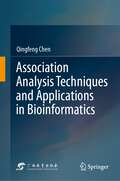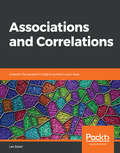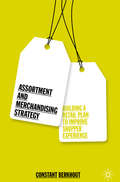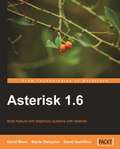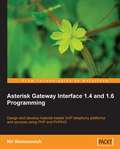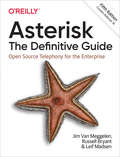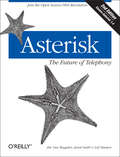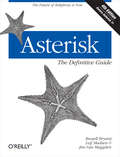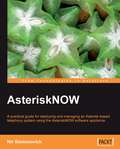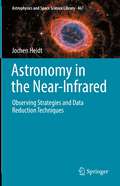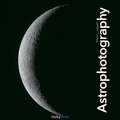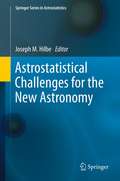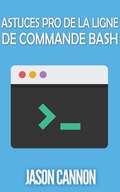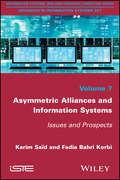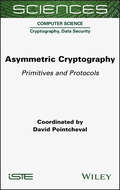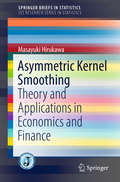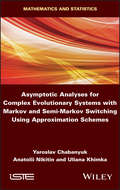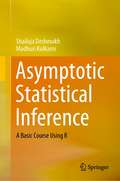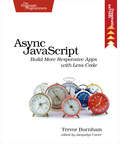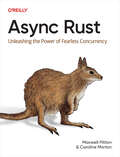- Table View
- List View
Association Analysis Techniques and Applications in Bioinformatics
by Qingfeng ChenAdvances in experimental technologies have given rise to tremendous amounts of biology data. This not only offers valuable sources of data to help understand biological evolution and functional mechanisms, but also poses challenges for accurate and effective data analysis. This book offers an essential introduction to the theoretical and practical aspects of association analysis, including data pre-processing, data mining methods/algorithms, and tools that are widely applied for computational biology. It covers significant recent advances in the field, both foundational and application-oriented, helping readers understand the basic principles and emerging techniques used to discover interesting association patterns in diverse and heterogeneous biology data, such as structure-function correlations, and complex networks with gene/protein regulation. The main results and approaches are described in an easy-to-follow way and accompanied by sufficientreferences and suggestions for future research. This carefully edited monograph is intended to provide investigators in the fields of data mining, machine learning, artificial intelligence, and bioinformatics with a profound guide to the role of association analysis in computational biology. It is also very useful as a general source of information on association analysis, and as an overall accompanying course book and self-study material for graduate students and researchers in both computer science and bioinformatics.
Associations and Correlations: Unearth the powerful insights buried in your data
by Lee BakerDiscover the story of your data using the essential elements of associations and correlations Key Features Get a comprehensive introduction to associations and correlations Explore multivariate analysis, understand its limitations, and discover the assumptions on which it's based Gain insights into the various ways of preparing your data for analysis and visualization Book Description Associations and correlations are ways of describing how a pair of variables change together as a result of their connection. By knowing the various available techniques, you can easily and accurately discover and visualize the relationships in your data. This book begins by showing you how to classify your data into the four distinct types that you are likely to have in your dataset. Then, with easy-to-understand examples, you'll learn when to use the various univariate and multivariate statistical tests. You'll also discover what to do when your univariate and multivariate results do not match. As the book progresses, it describes why univariate and multivariate techniques should be used as a tag team, and also introduces you to the techniques of visualizing the story of your data. By the end of the book, you'll know exactly how to select the most appropriate univariate and multivariate tests, and be able to use a single strategic framework to discover the true story of your data. What you will learn Identify a dataset that's fit for analysis using its basic features Understand the importance of associations and correlations Use multivariate and univariate statistical tests to confirm relationships Classify data as qualitative or quantitative and then into the four subtypes Build a visual representation of all the relationships in the dataset Automate associations and correlations with CorrelViz Who this book is for This is a book for beginners – if you're a novice data analyst or data scientist, then this is a great place to start. Experienced data analysts might also find value in this title, as it will recap the basics and strengthen your understanding of key concepts. This book focuses on introducing the essential elements of association and correlation analysis.
Assortment and Merchandising Strategy: Building a Retail Plan to Improve Shopper Experience
by Constant BerkhoutDemonstrating how retailers can tap into shoppers’ needs for variety without increasing complexity and stress, this innovative book combines cutting-edge research with hands-on, practical frameworks. Experts in the retail sector have long been convinced that small assortments are more appealing to shoppers than large selections of products; in other words, less is more. However, the human brain has an innate need for variety. Addressing this challenge Constant Berkhout offers practical merchandising guidelines both for stores and online retailers. Indeed, studies show that it is not the actual size of assortment that drives traffic to online stores, but the perception of assortment variety. The author illustrates how decisions around assortment and visual merchandising must be made in conjunction with each other, rather than separately, and provides a step-by-step plan to do so. Grounded on shopper needs, emotions and behaviours that apply to both online and brick-and-mortar stores, this book integrates assortment and merchandise thinking and takes a human and shopper perspective. With practical frameworks that can easily be implemented in real-life situations along with examples from a number of retail sectors, Assortment and Merchandising Strategy provides a deeper and much-needed understanding of how shoppers process information, and the strategies that retailers must adopt in order to satisfy and retain their customers.
Asterisk 1.4: The Professional’s Guide
by David Duffett Colman CarpenterEmploying a comprehensive handbook-style approach, this easy-to-follow book shows the reader various means of implementing the power of Asterisk in a commercial environment. In next to no time, the reader will gain a deeper understanding of many of the issues faced by Asterisk consultants and the solutions they believe work best. Primarily aimed at Asterisk Professionals, this book provides real-world insight for Asterisk Network Administrators and System Implementers in the commercial environment. This book is not for newcomers to Asterisk. Readers are expected to be experienced with installing and administering Asterisk systems.
Asterisk 1.6
by Barrie Dempster David GomillionThe book offers readers both a detailed description as well as step by step instructions on deploying software solutions as well as Asterisk configurations. Screenshots are provided in sections to give a visual perspective of the instructions. For Asterisk configurations actual sample code is listed in the book which can be directly inserted into your Asterisk solution.This book is aimed at anyone who is interested in building a powerful telephony system using the free and open source application, Asterisk, without spending many thousands of dollars buying a commercial and often less flexible system. This book is suitable for the novice and those new to Asterisk and telephony. Telephony or Linux experience will be helpful, but not required.
Asterisk Cookbook: Solutions to Everyday Telephony Problems
by Leif Madsen Russell BryantAsterisk has a wealth of features to help you customize your PBX to fill very specific business needs. This short cookbook offers recipes for tackling dialplan fundamentals, making and controlling calls, and monitoring channels in your PBX environment. Each recipe includes a simple code solution you can put to work immediately, along with a detailed discussion that offers insight into why and how the recipe works.This book focuses on Asterisk 1.8, although many of the conventions and information presented are version-agnostic. These recipes include solutions to help you:Authenticate callers before moving on in your dialplanRedirect calls received by your auto-attendantCreate an automatic call-back serviceInitiate hot-desking to login to and accept calls at any office deviceMonitor and interrupt live calls to train new employees at a call centerRecord calls from your Asterisk dialplan
Asterisk Gateway Interface 1.4 and 1.6 Programming
by Nir SimionovichThis friendly, clear tutorial takes a pragmatic approach to developing Asterisk applications, helping you to find the best solutions for your needs. Unlike most books, which simply show you how to do or what to do, this book tries to show you: "why to do?"--thus explaining the logic behind certain Asterisk development paradigms. This book is intended for developers wishing to utilize Asterisk, system administrators wishing to gain better control over their Asterisk installation, and telephony service providers wishing to deploy Asterisk-based solutions to their infrastructure. You are expected to have some experience with Asterisk and a basic understanding of programming. No knowledge of Asterisk programming is required.
Asterisk: Open Source Telephony for the Enterprise
by Leif Madsen Jim Van Meggelen Russell BryantDesign a complete Voice over IP (VoIP) or traditional PBX system with Asterisk, even if you have only basic telecommunications knowledge. This bestselling guide makes it easy with a detailed roadmap that shows you how to install and configure this open source software, whether you’re upgrading your existing phone system or starting from scratch.Ideal for Linux administrators, developers, and power users, this updated fifth edition shows you how to set up VoIP-based private telephone switching systems within the enterprise. You’ll get up to speed on the features in Asterisk 16, the latest long-term support release from Digium. This book also includes new chapters on WebRTC and the Asterisk Real-time Interface (ARI).Discover how WebRTC provides a new direction for AsteriskGain the knowledge to build a simple but complete phone systemBuild an interactive dialplan, using best practices for Asterisk’s advanced featuresLearn how ARI has emerged as the API of choice for interfacing web development languages with Asterisk
Asterisk: The Future of Telephony
by Leif Madsen Jared Smith Jim Van MeggelenThis bestselling book is now the standard guide to building phone systems with Asterisk, the open source IP PBX that has traditional telephony providers running scared! Revised for the 1.4 release of the software, the new edition of Asterisk: The Future of Telephony reveals how you can save money on equipment and support, and finally be in control of your telephone system.If you've worked with telephony in the past, you're familiar with the problem: expensive and inflexible systems that are tuned to the vendor's needs, not yours. Asterisk isn't just a candle in the darkness, it's a whole fireworks show. Because Asterisk is so powerful, configuring it can seem tricky and difficult. This book steps you through the process of installing, configuring, and integrating Asterisk with your existing phone system.You'll learn how to write dialplans, set up applications including speech synthesis and voice recognition, how to script Asterisk, and much more -- everything you need to design a simple but complete system with little or no Asterisk experience, and no more than rudimentary telecommunications knowledge. The book includes:A new chapter on managing/administering your Asterisk systemA new chapter on using Asterisk with databases Coverage of features in Asterisk 1.4A new appendix on dialplan functionsA simplified installation chapterNew simplified SIP configuration, including examples for several popular SIP clients (soft phones and IP telephones)Revised chapters and appendicies reviewed and updated for the latest in features, applications, trends and best-practicesAsterisk is revolutionizing the telecom industry, due in large part to the way it gets along with other network applications. While other PBXs are fighting their inevitable absorption into the network, Asterisk embraces it. If you need to take control of your telephony systems, move to Asterisk and see what the future of telecommunications looks like.
Asterisk: The Future of Telephony Is Now
by Leif Madsen Jim Van Meggelen Russell BryantDesign a complete VoIP or analog PBX with Asterisk, even if you have no previous Asterisk experience and only basic telecommunications knowledge. This bestselling guide makes it easy, with a detailed roadmap to installing, configuring, and integrating this open source software into your existing phone system. Ideal for Linux administrators, developers, and power users, this book shows you how to write a basic dialplan step by step, and quickly brings you up to speed on the latest Asterisk features in version 1.8. Integrate Asterisk with analog, VoIP, and digital telephony systems Build a simple interactive dialplan, and dive into advanced concepts Use Asterisk's voicemail options--including a standalone voicemail server Build a menuing system and add applications that act on caller input Incorporate a relational database with MySQL and Postgre SQL Connect to external services such as LDAP, calendars, XMPP, and Skype Use Automatic Call Distribution to build a call queuing system Learn how to use Asterisk's security, call routing, and faxing features
AsteriskNOW
by Nir SimionovichThis book is for complete beginners who are interested in setting up their own telephony system and are overwhelmed with the configuration options in Asterisk. It shows how to install and configure AsteriskNow and configure the required dial plan.
Asterisk™: The Future of Telephony
by Leif Madsen Jared Smith Jim Van MeggelenAsterisk allows users to implement flexible dialplans that support almost any telephony application, but its flexibility can make it difficult to install. This reference offers a complete roadmap for installing, configuring and integrating Asterisk with existing phone systems. It outlines all options and instructs readers in establishing voicemail, call conferencing, interactive voice response and other services and explains the underlying concepts of a basic dial plan.
Astronomy in the Near-Infrared - Observing Strategies and Data Reduction Techniques (Astrophysics and Space Science Library #467)
by Jochen HeidtNear-infrared astronomy has become one of the most rapidly developing branches in modern astrophysics. Innovative observing techniques, near-infrared detectors with quantum efficiencies in excess of 90%, highly specialised instruments as well as advanced data reduction techniques have allowed major breakthroughs in various areas like exoplanets, star-forming regions, the supermassive black hole in the Galactic center, and the high-redshift Universe. In this book, the reader will be introduced to the basic concepts of how to prepare near-infrared observations with maximized scientific return. Equal weight is given to all aspects of the data reduction for both - imaging and spectroscopy. Information is also provided on the state of the art instrumentation available and planned, on detector technology or the physics of the atmosphere, all of which influence the preparation and execution of observations and data reduction techniques. The beginner but also the expert will find a lot of information in compact form which is otherwise widely dispersed across the internet or other sources.
Astrophotography
by Thierry LegaultToday's photographic equipment allows amateurs to take pictures of the stars that far surpass images taken just a few decades ago by even the largest observatories-and this book will teach you how.Author and world-renowned astrophotographer Thierry Legault teaches the art and techniques of astrophotography: from simple camera-on-tripod night-scene imaging of constellations, star trails, eclipses, artificial satellites, and polar auroras to more intensive astrophotography using specialized equipment for lunar, planetary, solar, and deep-sky imaging. Legault shares advice on equipment and guides you through techniques to capture and process your images to achieve spectacular results.Astrophotography provides the most thorough treatment of the topic available. This large-format, richly illustrated book is intended for all sky enthusiasts-newcomers and veterans alike.Learn how to:Select the most useful equipment: cameras, adapters, filters, focal reducers/extenders, field correctors, and guide telescopes Set up your camera (digital, video, or CCD) and your lens or telescope for optimal resultsPlan your observing sessionsMount the camera on your telescope and focus it for razor-sharp imagesPolar-align your equatorial mount and improve tracking for pin-point star imagesMake celestial time-lapse videosCalculate the shooting parameters: focal length and ratio, field of view, exposure time, etc.Combine multiples exposures to reveal faint galaxies, nebulae details, elusive planetary structures, and tiny lunar craters Adjust contrast, brightness, light curves, and colorsPostprocess your images to fix defects such as vignetting, dust shadows, hot pixels, uneven background, and noiseIdentify problems with your images and improve your results
Astrophysics Through Computation
by Brian Koberlein David MeiselThis new text surveys a series of fundamental problems in astrophysics, both analytically and computationally for advanced students in physics and astrophysics. The contents are supported by over 110 class-tested Mathematica notebooks, allowing rigorous solutions to be explored in a visually engaging way. Topics covered include many classical and historically interesting problems, enabling the students to appreciate the mathematical and scientific challenges that were overcome in the subject's development. The text also shows the advantages and disadvantages of using analytical and computational methods. It will serve students, professionals, and capable amateurs to master the quantitative details of modern astrophysics and the computational aspects of their research projects.
Astrostatistical Challenges for the New Astronomy (Springer Series in Astrostatistics #1)
by Joseph M. HilbeAstrostatistical Challenges for the New Astronomy presents a collection of monographs authored by several of the disciplines leading astrostatisticians, i.e. by researchers from the fields of statistics and astronomy-astrophysics, who work in the statistical analysis of astronomical and cosmological data. Eight of the ten monographs are enhancements of presentations given by the authors as invited or special topics in astrostatistics papers at the ISI World Statistics Congress (2011, Dublin, Ireland). The opening chapter, by the editor, was adapted from an invited seminar given at Los Alamos National Laboratory (2011) on the history and current state of the discipline; the second chapter by Thomas Loredo was adapted from his invited presentation at the Statistical Challenges in Modern Astronomy V conference (2011, Pennsylvania State University), presenting insights regarding frequentist and Bayesian methods of estimation in astrostatistical analysis. The remaining monographs are research papers discussing various topics in astrostatistics. The monographs provide the reader with an excellent overview of the current state astrostatistical research, and offer guidelines as to subjects of future research. Lead authors for each chapter respectively include Joseph M. Hilbe (Jet Propulsion Laboratory and Arizona State Univ); Thomas J. Loredo (Dept of Astronomy, Cornell Univ); Stefano Andreon (INAF-Osservatorio Astronomico di Brera, Italy); Martin Kunz ( Institute for Theoretical Physics, Univ of Geneva, Switz); Benjamin Wandel ( Institut d'Astrophysique de Paris, Univ Pierre et Marie Curie, France); Roberto Trotta (Astrophysics Group, Dept of Physics, Imperial College London, UK); Phillip Gregory (Dept of Astronomy, Univ of British Columbia, Canada); Marc Henrion (Dept of Mathematics, Imperial College, London, UK); Asis Kumar Chattopadhyay (Dept of Statistics, Univ of Calcutta, India); Marisa March (Astrophysics Group, Dept of Physics, Imperial College, London, UK).
Astuces Pro de la Ligne de Commande Bash
by Jason Cannon Avinash MayaramSi vous vous êtes déjà dit, « Il doit y avoir une meilleure façon de faire cela », alors lisez la suite. Ayant utilisé le shell Bash presque tous les jours, depuis plus de 15 ans, j’ai accumulé plusieurs astuces de la ligne de commande qui m’ont économisé du temps et de la frustration. Astuces Pro de la Ligne de Commande Bash est une collection de 10 techniques que vous pouvez utiliser immédiatement pour augmenter votre efficacité sur la ligne de commande. Voici ce que vous apprendrez en lisant Astuces Pro de la Ligne de Commande Bash : Astuce 1 : Saisie semi-automatique par Tabulation Astuce 2 : Accéder au Répertoire Précédent Astuce 3 : Réutiliser le Dernier Élément de la Précédente Ligne de Commande Astuce 4 : Relancer une Commande Qui Commence par une Chaîne donnée Astuce 5 : Substitution de Commande Astuce 6 : Utiliser une Boucle pour à la Ligne de Commande Astuce 7 : Relancer la Commande Précédente avec les Privilèges Root Astuce 8 : Relancer la Commande Précédente En Substituant une Chaîne Astuce 9 : Réutiliser un Mot sur la Même Ligne de Commande Astuce 10 : Corriger les Fautes de frappe et Raccourcir les Longues Commandes avec des Alias
Asymmetric Alliances Management via Information Systems: Issues and Prospects
by Fadia Bahri Korbi Karim SaidThis book explores the impact of information systems on the management of North–South asymmetric strategic alliances through a series of in-depth case studies which analyze different types of partnerships. Positioned at the heart of the value creation process, the choice of information system seems to be becoming a strategic issue which should be centered not only on the organizational decisions related to the type of alliance but also the management systems of each of the partners. The authors provide an understanding of the nature of this relationship between the organizational structure and the method of information system integration in asymmetric alliances. The in-depth analysis of strategic alliance case-studies illustrates the different methods of information system integration, which are themselves linked to the organisational and structural choices of the alliance. These methods are characterized by information-sharing and coordination mechanisms as well as the balance of control over shared activities developed by the distinct partners.
Asymmetric Cryptography: Primitives and Protocols
by David PointchevalPublic key cryptography was introduced by Diffie and Hellman in 1976, and it was soon followed by concrete instantiations of public-key encryption and signatures; these led to an entirely new field of research with formal definitions and security models. Since then, impressive tools have been developed with seemingly magical properties, including those that exploit the rich structure of pairings on elliptic curves. <p><p> Asymmetric Cryptography starts by presenting encryption and signatures, the basic primitives in public-key cryptography. It goes on to explain the notion of provable security, which formally defines what "secure" means in terms of a cryptographic scheme. A selection of famous families of protocols are then described, including zero-knowledge proofs, multi-party computation and key exchange. <p><p> After a general introduction to pairing-based cryptography, this book presents advanced cryptographic schemes for confidentiality and authentication with additional properties such as anonymous signatures and multi-recipient encryption schemes. Finally, it details the more recent topic of verifiable computation.
Asymmetric Kernel Smoothing: Theory and Applications in Economics and Finance (SpringerBriefs in Statistics)
by Masayuki HirukawaThis is the first book to provide an accessible and comprehensive introduction to a newly developed smoothing technique using asymmetric kernel functions. Further, it discusses the statistical properties of estimators and test statistics using asymmetric kernels. The topics addressed include the bias-variance tradeoff, smoothing parameter choices, achieving rate improvements with bias reduction techniques, and estimation with weakly dependent data. Further, the large- and finite-sample properties of estimators and test statistics smoothed by asymmetric kernels are compared with those smoothed by symmetric kernels. Lastly, the book addresses the applications of asymmetric kernel estimation and testing to various forms of nonnegative economic and financial data. Until recently, the most popularly chosen nonparametric methods used symmetric kernel functions to estimate probability density functions of symmetric distributions with unbounded support. Yet many types of economic and financial data are nonnegative and violate the presumed conditions of conventional methods. Examples include incomes, wages, short-term interest rates, and insurance claims. Such observations are often concentrated near the boundary and have long tails with sparse data. Smoothing with asymmetric kernel functions has increasingly gained attention, because the approach successfully addresses the issues arising from distributions that have natural boundaries at the origin and heavy positive skewness. Offering an overview of recently developed kernel methods, complemented by intuitive explanations and mathematical proofs, this book is highly recommended to all readers seeking an in-depth and up-to-date guide to nonparametric estimation methods employing asymmetric kernel smoothing.
Asymptotic Analyses for Complex Evolutionary Systems with Markov and Semi-Markov Switching Using Approximation Schemes
by Yaroslav Chabanyuk Anatolii Nikitin Uliana KhimkaThis book analyzes stochastic evolutionary models under the impulse of diffusion, as well as Markov and semi-Markov switches. Models are investigated under the conditions of classical and non-classical (Levy and Poisson) approximations in addition to jumping stochastic approximations and continuous optimization procedures. Among other asymptotic properties, particular attention is given to weak convergence, dissipativity, stability and the control of processes and their generators. Weak convergence of stochastic processes is usually proved by verifying two conditions: the tightness of the distributions of the converging processes, which ensures the existence of a converging subsequence, and the uniqueness of the weak limit. Achieving the limit can be done on the semigroups that correspond to the converging process as well as on appropriate generators. While this provides the convergence of generators, a natural question arises concerning the uniqueness of a limit semigroup.
Asymptotic Nonparametric Statistical Analysis of Stationary Time Series (SpringerBriefs in Computer Science)
by Daniil RyabkoStationarity is a very general, qualitative assumption, that can be assessed on the basis of application specifics. It is thus a rather attractive assumption to base statistical analysis on, especially for problems for which less general qualitative assumptions, such as independence or finite memory, clearly fail. However, it has long been considered too general to be able to make statistical inference. One of the reasons for this is that rates of convergence, even of frequencies to the mean, are not available under this assumption alone. Recently, it has been shown that, while some natural and simple problems, such as homogeneity, are indeed provably impossible to solve if one only assumes that the data is stationary (or stationary ergodic), many others can be solved with rather simple and intuitive algorithms. The latter include clustering and change point estimation among others. In this volume I summarize these results. The emphasis is on asymptotic consistency, since this the strongest property one can obtain assuming stationarity alone. While for most of the problem for which a solution is found this solution is algorithmically realizable, the main objective in this area of research, the objective which is only partially attained, is to understand what is possible and what is not possible to do for stationary time series. The considered problems include homogeneity testing (the so-called two sample problem), clustering with respect to distribution, clustering with respect to independence, change point estimation, identity testing, and the general problem of composite hypotheses testing. For the latter problem, a topological criterion for the existence of a consistent test is presented. In addition, a number of open problems is presented.
Asymptotic Statistical Inference: A Basic Course Using R
by Shailaja Deshmukh Madhuri KulkarniThe book presents the fundamental concepts from asymptotic statistical inference theory, elaborating on some basic large sample optimality properties of estimators and some test procedures. The most desirable property of consistency of an estimator and its large sample distribution, with suitable normalization, are discussed, the focus being on the consistent and asymptotically normal (CAN) estimators. It is shown that for the probability models belonging to an exponential family and a Cramer family, the maximum likelihood estimators of the indexing parameters are CAN. The book describes some large sample test procedures, in particular, the most frequently used likelihood ratio test procedure. Various applications of the likelihood ratio test procedure are addressed, when the underlying probability model is a multinomial distribution. These include tests for the goodness of fit and tests for contingency tables. The book also discusses a score test and Wald’s test, their relationship with the likelihood ratio test and Karl Pearson’s chi-square test. An important finding is that, while testing any hypothesis about the parameters of a multinomial distribution, a score test statistic and Karl Pearson’s chi-square test statistic are identical. Numerous illustrative examples of differing difficulty level are incorporated to clarify the concepts. For better assimilation of the notions, various exercises are included in each chapter. Solutions to almost all the exercises are given in the last chapter, to motivate students towards solving these exercises and to enable digestion of the underlying concepts. The concepts from asymptotic inference are crucial in modern statistics, but are difficult to grasp in view of their abstract nature. To overcome this difficulty, keeping up with the recent trend of using R software for statistical computations, the book uses it extensively, for illustrating the concepts, verifying the properties of estimators and carrying out various test procedures. The last section of the chapters presents R codes to reveal and visually demonstrate the hidden aspects of different concepts and procedures. Augmenting the theory with R software is a novel and a unique feature of the book. The book is designed primarily to serve as a text book for a one semester introductory course in asymptotic statistical inference, in a post-graduate program, such as Statistics, Bio-statistics or Econometrics. It will also provide sufficient background information for studying inference in stochastic processes. The book will cater to the need of a concise but clear and student-friendly book introducing, conceptually and computationally, basics of asymptotic inference.
Async JavaScript: Build More Responsive Apps with Less Code
by Trevor BurnhamWith the advent of HTML5, front-end MVC, and Node.js, JavaScript is ubiquitous--and still messy. This book will give you a solid foundation for managing async tasks without losing your sanity in a tangle of callbacks. It's a fast-paced guide to the most essential techniques for dealing with async behavior, including PubSub, evented models, and Promises. With these tricks up your sleeve, you'll be better prepared to manage the complexity of large web apps and deliver responsive code.With Async JavaScript, you'll develop a deeper understanding of the JavaScript language. You'll start with a ground-up primer on the JavaScript event model--key to avoiding many of the most common mistakes JavaScripters make. From there you'll see tools and design patterns for turning that conceptual understanding into practical code.The concepts in the book are illustrated with runnable examples drawn from both the browser and the Node.js server framework, incorporating complementary libraries including jQuery, Backbone.js, and Async.js. You'll learn how to create dynamic web pages and highly concurrent servers by mastering the art of distributing events to where they need to be handled, rather than nesting callbacks within callbacks within callbacks.Async JavaScript will get you up and running with real web development quickly. By the time you've finished the Promises chapter, you'll be parallelizing Ajax requests or running animations in sequence. By the end of the book, you'll even know how to leverage Web Workers and AMD for JavaScript applications with cutting-edge performance. Most importantly, you'll have the knowledge you need to write async code with confidence.What You Need:Basic knowledge of JavaScript is recommended. If you feel that you're not up to speed, see the "Resources for Learning JavaScript" section in the preface.
Async Rust
by Maxwell Flitton Caroline MortonAlready popular among programmers for its memory safety and speed, the Rust programming language is also valuable for asynchrony. This practical book shows you how asynchronous Rust can help you solve problems that require multitasking. You'll learn how to apply async programming to solve problems with an async approach. You will also dive deeper into async runtimes, implementing your own ways in which async runtimes handle incoming tasks.Authors Maxwell Flitton and Caroline Morton also show you how to implement the Tokio software library to help you with incoming traffic, communicate between threads with shared memory and channels, and design a range of complex solutions using actors. You'll also learn to perform unit and end-to-end tests on a Rust async system.With this book, you'll learn:How Rust approaches async programmingHow coroutines relate to async RustReactive programming and how to implement pub sub in async rustHow to solve problems using actorsHow to customize Tokio to gain control over how tasks are processedAsync Rust design patternsHow to build an async TCP server just using the standard libraryHow to unit test async RustBy the end of the book, you'll be able to implement your own async TCP server completely from the standard library with zero external dependencies, and unit test your async code.
